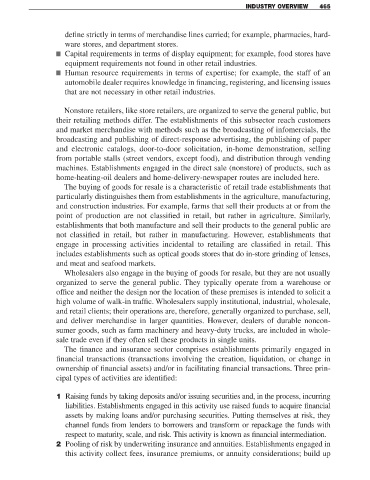Page 487 - Solid Waste Analysis and Minimization a Systems Approach
P. 487
INDUSTRY OVERVIEW 465
define strictly in terms of merchandise lines carried; for example, pharmacies, hard-
ware stores, and department stores.
■ Capital requirements in terms of display equipment; for example, food stores have
equipment requirements not found in other retail industries.
■ Human resource requirements in terms of expertise; for example, the staff of an
automobile dealer requires knowledge in financing, registering, and licensing issues
that are not necessary in other retail industries.
Nonstore retailers, like store retailers, are organized to serve the general public, but
their retailing methods differ. The establishments of this subsector reach customers
and market merchandise with methods such as the broadcasting of infomercials, the
broadcasting and publishing of direct-response advertising, the publishing of paper
and electronic catalogs, door-to-door solicitation, in-home demonstration, selling
from portable stalls (street vendors, except food), and distribution through vending
machines. Establishments engaged in the direct sale (nonstore) of products, such as
home-heating-oil dealers and home-delivery-newspaper routes are included here.
The buying of goods for resale is a characteristic of retail trade establishments that
particularly distinguishes them from establishments in the agriculture, manufacturing,
and construction industries. For example, farms that sell their products at or from the
point of production are not classified in retail, but rather in agriculture. Similarly,
establishments that both manufacture and sell their products to the general public are
not classified in retail, but rather in manufacturing. However, establishments that
engage in processing activities incidental to retailing are classified in retail. This
includes establishments such as optical goods stores that do in-store grinding of lenses,
and meat and seafood markets.
Wholesalers also engage in the buying of goods for resale, but they are not usually
organized to serve the general public. They typically operate from a warehouse or
office and neither the design nor the location of these premises is intended to solicit a
high volume of walk-in traffic. Wholesalers supply institutional, industrial, wholesale,
and retail clients; their operations are, therefore, generally organized to purchase, sell,
and deliver merchandise in larger quantities. However, dealers of durable noncon-
sumer goods, such as farm machinery and heavy-duty trucks, are included in whole-
sale trade even if they often sell these products in single units.
The finance and insurance sector comprises establishments primarily engaged in
financial transactions (transactions involving the creation, liquidation, or change in
ownership of financial assets) and/or in facilitating financial transactions. Three prin-
cipal types of activities are identified:
1 Raising funds by taking deposits and/or issuing securities and, in the process, incurring
liabilities. Establishments engaged in this activity use raised funds to acquire financial
assets by making loans and/or purchasing securities. Putting themselves at risk, they
channel funds from lenders to borrowers and transform or repackage the funds with
respect to maturity, scale, and risk. This activity is known as financial intermediation.
2 Pooling of risk by underwriting insurance and annuities. Establishments engaged in
this activity collect fees, insurance premiums, or annuity considerations; build up

